13/05/2017
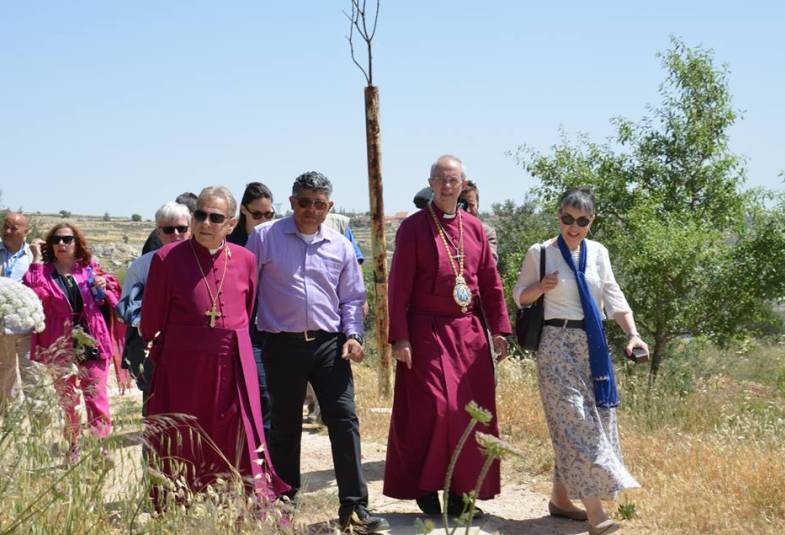
The Archbishop of Canterbury has completed a 10-day official visit to the Holy Land.
Archbishop Justin Welby and Mrs Caroline Welby travelled to the Holy Land at the invitation of the Anglican Bishop in Jerusalem, Archbishop Suheil Dawani.
The Archbishop made the long visit, from 2–11 May, to spend time with Anglicans in Jordan, the Occupied Palestinian Territories and Israel – to encourage them, to pray with them, and to learn from them.
He also met with other religious leaders, both Christian and of other faiths, to speak with them and learn from them, and to encourage working together.
During the visit the Archbishop also met with political leaders, urging them to preserve human dignity, prevent human suffering and strive for peace above all else.
Throughout the trip, the Archbishop was accompanied by Archbishop Suheil, and spent time in prayer and worship with the community of St George’s Anglican Cathedral in Jerusalem. He also saw some of the vital ministry of the Cathedral and the wider Episcopal Diocese of Jerusalem in the region, particularly in healthcare, education and pursuing reconciliation.
Day 1: Jordan
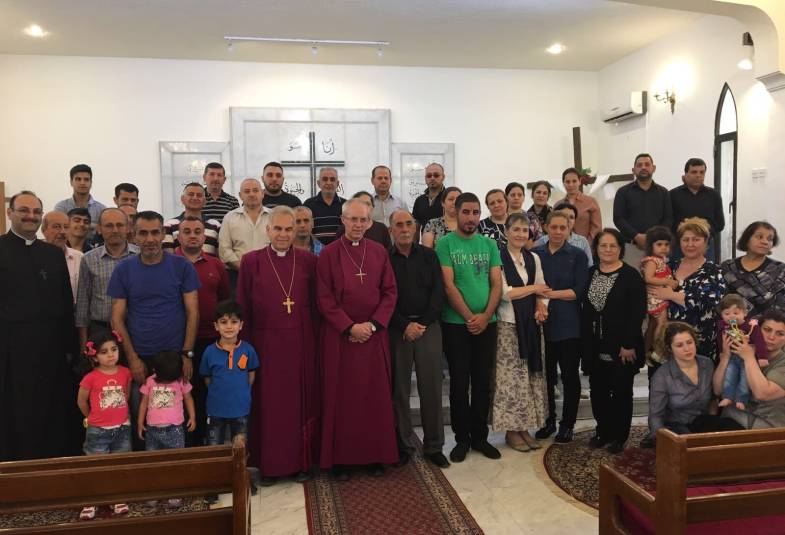
The Archbishop’s tour began in Jordan. Accompanied by Archbishop Suheil, he visited Zaatari refugee camp and met with Syrian refugees. He also met with Iraqi Christian refugees at the Anglican St. Paul’s Church in Ashrafiyeh, Amman. The Archbishops spent time listening to their stories.
Reflecting on the meeting Archbishop Justin said: “The intense suffering of Iraqi Christians does not end when they leave Iraq. As I listened, there was this awful sense of lives torn apart. People are divided from their children and families and have no idea what will happen.”
The Archbishop said the Iraqi Christians he met “feel the world has forgotten them, because the focus of the international community is now on Syria. Iraqis, they say, are at the bottom of the list when it comes to resettlement or support.”
He added: “As we left I prayed for God's protection over their community. And I prayed that we, the Western Church, would be stirred up to do something. We are human beings with our persecuted brothers and sisters. We must embrace them.”
Day 2: Jerusalem
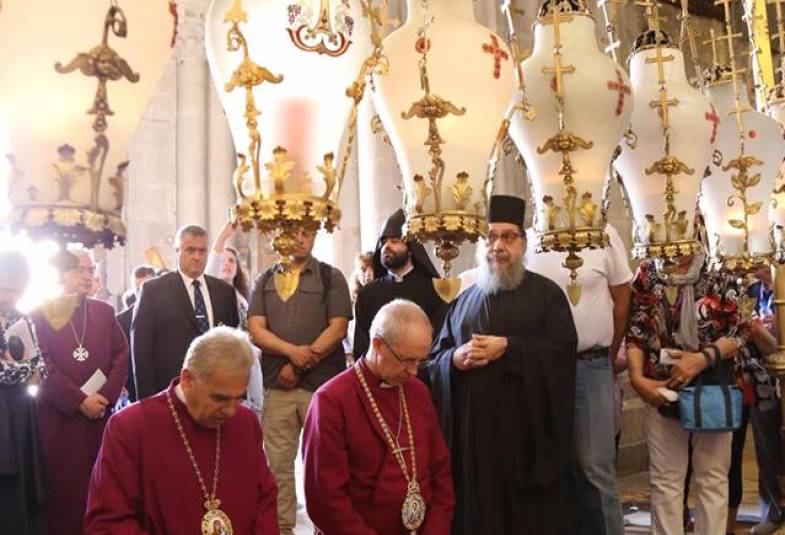
On the second day, the Archbishop travelled from Amman to Jerusalem, stopping to pray at the site of Christ’s Baptism on the eastern bank of the River Jordan.
On arriving in Jerusalem, accompanied by Archbishop Suheil, the Archbishop walked and prayed at the Stations of Cross along the Via Dolorosa in the Old City. He was then warmly received at the Church of the Holy Sepulchre by the Greek Orthodox Patriarch, His Beatitude, Theophilos III, and Archbishop Aristarchos of Constantina at the Church of the Holy Sepulchre.
The Archbishop then visited Haram al-Sharif, where he was given a tour by the Director of the Waqf, Sheikh Azzam al-Khatib.
In the afternoon the Archbishop was joined by UK Chief Rabbi Ephraim Mirvis. The Archbishop and Chief Rabbi prayed for peace together at the Western Wall, before visiting the Yad Vashem Holocaust Memorial in Jerusalem, which they toured before laying wreaths and praying at the memorial.
Speaking at Yad Vashem about the history of anti-Semitism, and its recent resurgence in England, the Archbishop said: “We must dedicate ourselves afresh, as the Chief Rabbi has put so beautifully, to building and maintaining bridges of friendship, understanding tolerance and peace.
“Coming here today I am reminded how important that is, and particularly when having spoken to members of Parliament over the last few months who are Jewish, they have spoken of the upsurge in attacks on them and the wickedness that they have suffered.
“To build these bridges is an essential, and the bridges must carry us to a place where to attack someone because they are Jewish, in our words, even in our deepest thoughts, is something that is only found mysteriously in old history books, because it is so far behind us. Nothing less is enough.”
During their time together in Jerusalem, the Archbishop and Chief Rabbi met with Israel’s Chief Rabbis. They also met with the friends of the British student Hannah Bladon who was murdered in Jerusalem last month. They prayed with them and heard moving tributes to Hannah.
Day 3: Gaza
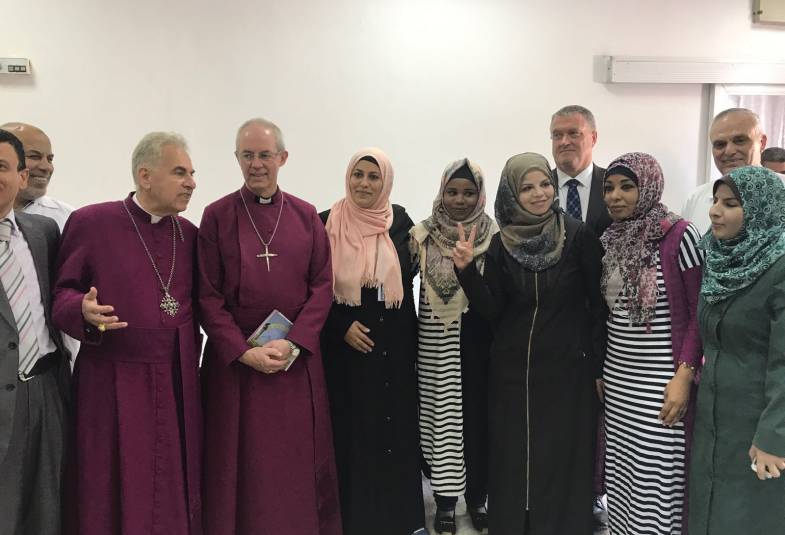
The following day Archbishop Justin visited the Gaza Strip. Joined by Archbishop Suheil, he visited two hospitals in Gaza City – St John’s Eye Hospital and the Al Ahli Arab Hospital, which is run by the Episcopal Diocese of Jerusalem.
While at Al Ahli Arab Hospital, Archbishop Justin led worship in the chapel, and met members of Gaza’s Christian community to hear about the challenges they face.
The Archbishop also visited Gaza War Cemetery, where British and imperial troops who fought in Gaza in 1917 are buried.
Speaking after the visit, the Archbishop described Gaza as “a place that feels profoundly isolated and besieged… the place where you felt all the problems of the area come together most clearly.” But he also spoke of the “extraordinary” ministry of the Anglican church in Gaza in the area of healthcare.
Day 4: Nazareth
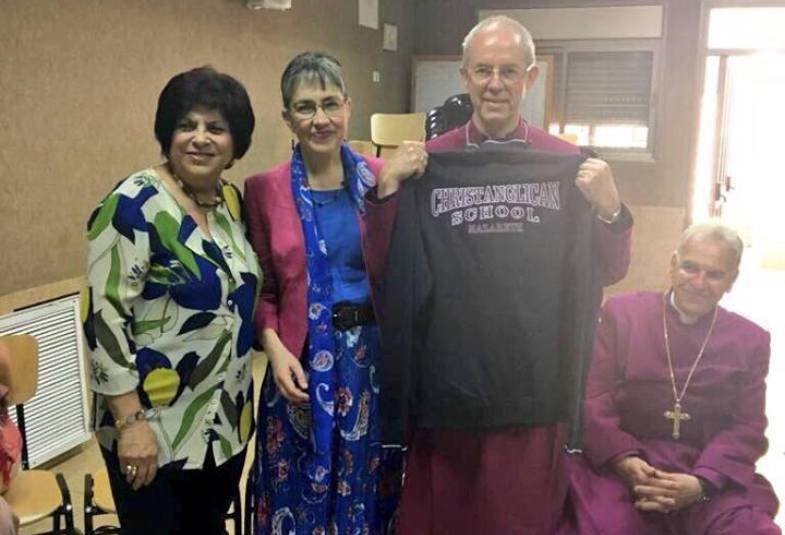
The Archbishop spent the day visiting Christian churches and communities in Nazareth. In the morning he visited Christ Anglican School, where he met with Christian and Muslim students and their teachers.
Archbishop Justin said: “It was brilliant to visit the thriving Anglican school in the heart of Nazareth. The students at Christ School are capable, articulate, hopeful young people who have so much to contribute to their communities and to the common good. It was especially delightful to see the strength of relationship between Christian and Muslim students within an Anglican spirit.
After visiting and praying at the Nazareth’s Greek Orthodox and Roman Catholic churches, the Archbishop joined midday prayers at the Anglican Christ Church.
Speaking that evening, the Archbishop said the “vibrancy” of many he had met in Nazareth – amidst the stresses and strains they face – was “a wonderful picture of what the grace of God does.”
Day 6: Jerusalem
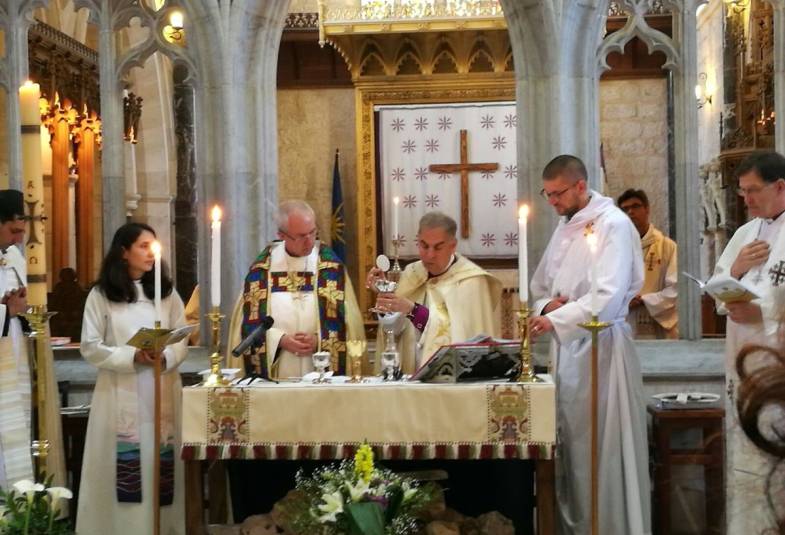
After spending the previous day of Shabbat in the Galilee, the Archbishop Justin was returned to St George’s Cathedral, Jerusalem. He began the day presiding at Holy Communion with Archbishop Suheil.
Preaching at the service, Archbishop Justin said: “The church carries within it the possibility of abundant life, and when the church roots itself in Jesus Christ and in obedience to Him then the abundant life spills out for the healing of the nations. Here in this region is a deep need for healing, for hope for righteousness of life, and for human dignity in security and without fear.
“The presence of Christians here both needs that abundant life if the church is to remain, but also is essential to the life and hope of this whole area.
“We pray for you, grieve for you, hope with you, and will seek in the best ways we can, to support you that we share the abundant life of Christ.”
In the afternoon the Archbishop was installed as an Episcopal Canon at St George’s Cathedral, at a service attended by local clergy and ecumenical guests from churches in Jerusalem
Day 7: Bethlehem
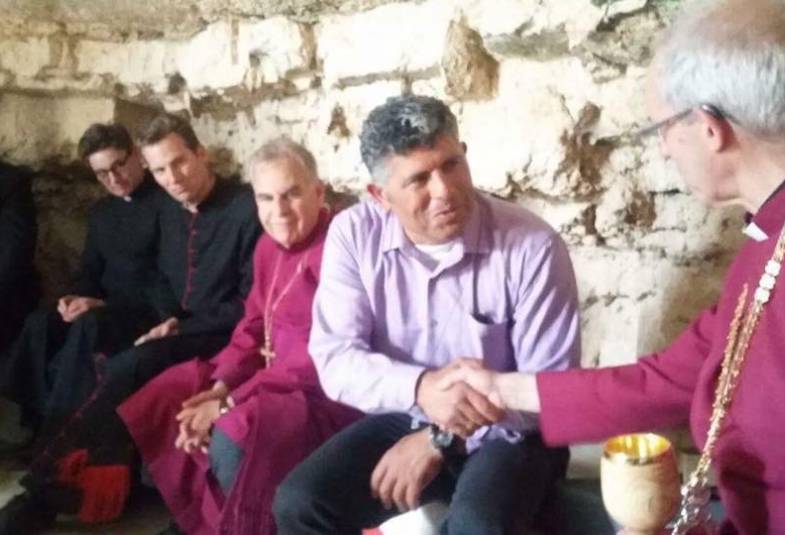
The Archbishop spent this day visiting Christian communities in Bethlehem and the surrounding area.
He began the day at morning prayer at St George’s Chapel in the Church of the Nativity. The service was led by Dean Hosam Naoum, and the Archbishop and his delegation were welcomed by the Greek Orthodox Archbishop of Jordan, Thephylactos, who intoned the Gospel at the service, as well as the Mayor of Bethlehem, Vera Baboun.
Following the service the delegation visited and prayed at the Grotto of the Nativity and met the Roman Catholic priests in charge of the Grotto of the Manger.
The Archbishop met with Mayor Baboun and the Friends of the Holy Land, to hear about the current situation in Bethlehem.
He then visited the Cremisan Valley area and met with families in Beit Jala who are separated from their land by the separation barrier. After hearing about the challenges they face, the Archbishop prayed at the wall for peace in the Holy Land.
Later the Archbishop visited Daoud Nassar at his family’s farm outside Bethlehem, which has been owned and cultivated by the Nassar family for over 100 years. The project run from the farm - Tent of Nations - aims to create a space of reconciliation and peace through the harvest activities, summer camps, and women’s empowerment projects. The motto of the project is “we refuse to be enemies”, and volunteers come from around the world to work the land and to build peace together.
Later that day the Archbishop met with Palestinian president Mahmoud Abbas in Ramallah.
In comments to the media, the Archbishop spoke of the vital need for co-existence between different faith communities in the region, and of the responsibilities of religious leaders.
“I believe emphatically and determinedly and without hesitation that they must find a way of living together,” he said. “The idea of a religious apartheid, of separate development, would be a catastrophe because this region sets the pattern for so many other parts of the world.”
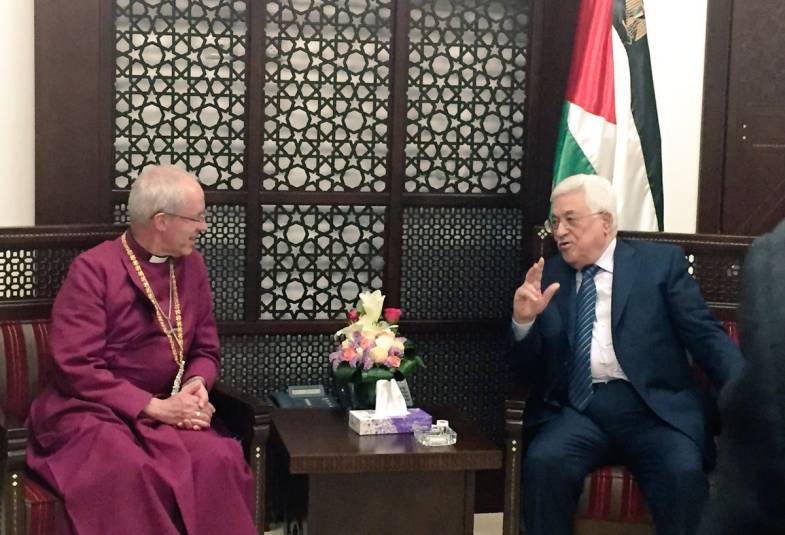
He added: “It’s going to require enormous leadership from within each of the religious traditions. And it requires a new form of integrity in which religious leaders takes responsibility for failures within their traditions.”
In the past decade or so, “there’s been a total breakdown of the capacity of human beings to live alongside one another. But in the Middle East, it’s happened before and it’s been put right before, and there have been new moments of hope. So that’s our prayer. And that’s what we have to take responsibility for leading.”
Day 8: Jerusalem
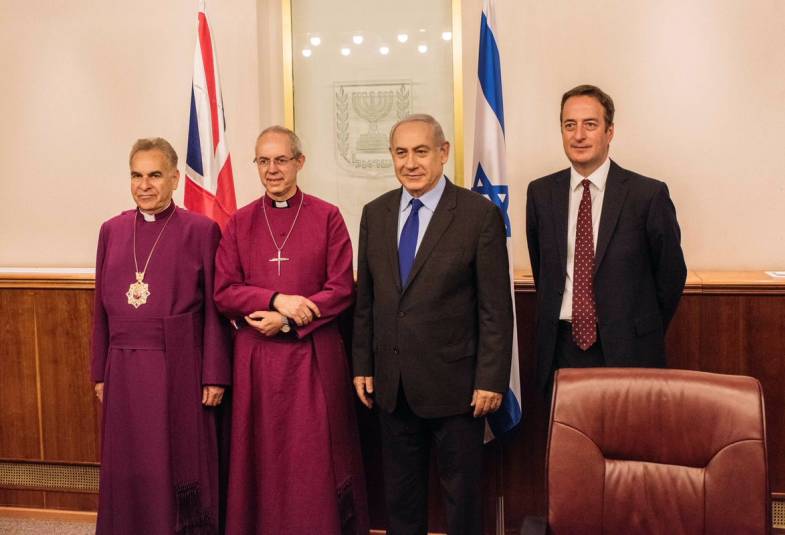
The Archbishop had a series of meetings with Israeli leaders and public figures: Prime Minister Benjamin Netanyahu, President Reuven Rivlin, and Chief Justice Miriam Naor and Supreme Court Judge Salim Joubran. The Archbishop said his meeting with the Israeli Prime Minister was a “positive” conversation about political challenges, faith issues and hopes for peace.
Speaking to the media after his meetings with both Palestinian and Israeli political leaders, the Archbishop said: “It does seem, listening to many, that internationally perhaps the planets are aligning. Perhaps a moment of opportunity is coming that may not repeat itself for a while. As a Christian, as a religious leader, my hope and prayer is that we can find a way within the region of confidence being rebuilt.”
He added: “There cannot be peace without every person in the region – Israeli, Israeli-Jewish, Israeli-Arab, Palestinian, all of them – being sure they can pursue their lives, pursue their aims, without fearing the bomb or the bullet, without fearing persecution.”
Later that day the Archbishop returned to the Jordan River Baptism site, this time visiting its western bank, where he saw the work of the British mine clearance charity the HALO Trust. Last year the charity was granted approval by both Israeli and Palestinian authorities, and eight Christian denominations, to begin mine clearance at the site, which they are raising funds for through an appeal to congregations and foundations worldwide.
Speaking at the site, the Archbishop said: “I’m inspired by what HALO is doing as I see them using weapons of war to bring hope of peace.”
The Archbishop began the day with a visit to the Princess Basma Centre in the Mount of Olives in Jerusalem, which supports children with physical and learning difficulties. During the visit, Caroline Welby met with Palestinian mothers to discuss the benefits of treatment for their children, the challenges they face in receiving the treatment, both at home and in travelling to the centre from the West Bank.
Day 9: Hebron
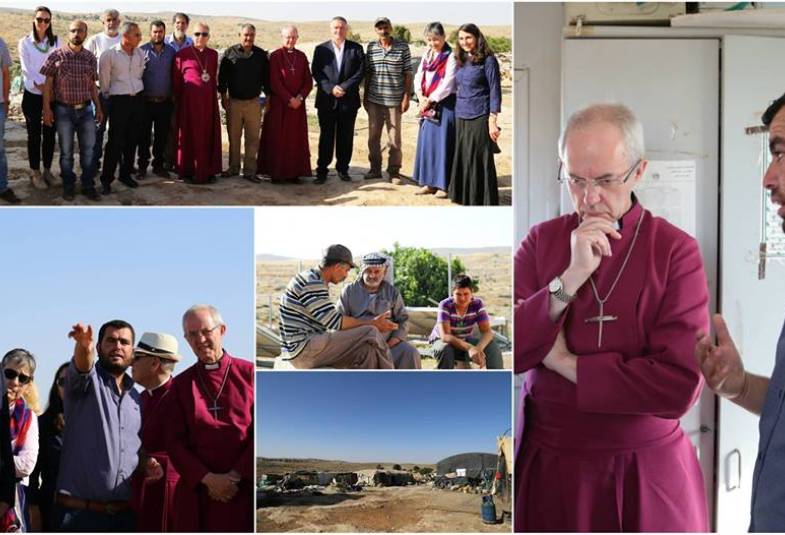
On the penultimate day of the trip, the Archbishop started the day in the Bedouin village of Susiya in the South Hebron Hills. The village is home to 350 people – 45 families – whose homes have been demolished seven times since 1993. Archbishop Justin heard how bulldozers have repeatedly destroyed their houses, animal shelters and water systems. They are anticipating the eight round of demolitions at any time.
“Every human being is made in the image of God and every human being deserves to live in peace and security," said Archbishop Justin. "This is not Jewish against Muslim or anything like that. This is about justice. I've been deeply touched by what I've seen and heard and I hope you'll join me in praying for all the Bedouin communities whose homes risk demolition.”
Archbishop Justin then travelled to the West Bank city of Hebron. There he received a briefing from the Hebron Rehabilitation Committee and heard about the successful restoration projects they have completed. The Archbishop then toured the H2 area, which is under Israeli military control, and visited the souq, where he met the Women in Hebron co-operative.
He visited the Ibrahimi Mosque, known to Jews as the Cave of the Patriarchs, which is divided into a mosque and a synagogue – both of which the Archbishop visited.
Finally the Archbishop walked the length of Shuhada Street, the main street in Hebron, on which Palestinians are prohibited from walking or driving. During the walk he paused to pray for “resurrection and reconciliation” in the city.
Day 10: Tel Aviv-Jaffa
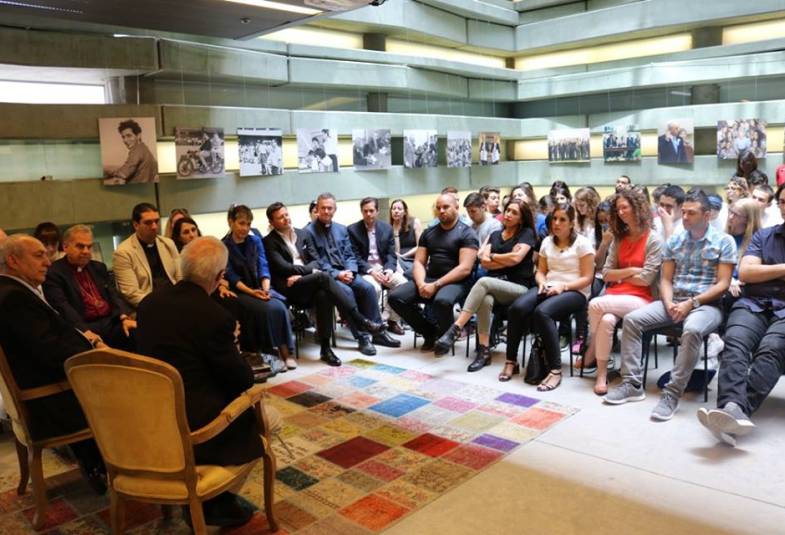
The Archbishop began his final day in the Holy Land with a visit to the Equalizer co-existence football project for Arab and Jewish youth.
He then gave a speech at the Peres Center for Peace to an audience of young people, in which he focused on the theme of reconciliation.
In his final stop of the 10-day tour, the Archbishop visited St Peter’s Anglican Church in Jaffa, which is in the early stages of reopening after years of laying damaged and disused since the fighting in 1948. Archbishop Justin and Archbishop Suheil prayed together at the site for the renewal of the Church in the Holy Land, and for justice, peace and reconciliation.
Speaking at a press conference the previous evening, the Archbishop said what had struck him most powerfully during the trip was “the overwhelming need for peace. The need for political leaders of all sorts to have nothing more prominent in their minds each day that they wake up, than the search for peace in this land, in both Israel and Palestine, in the whole region.”